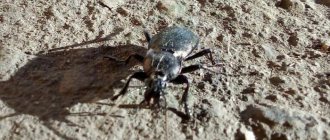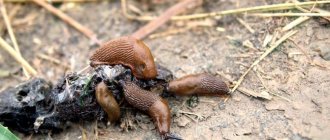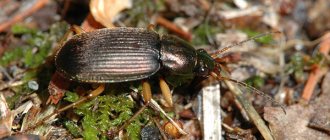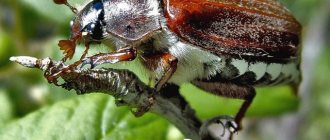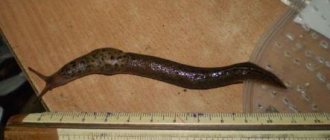It is impossible to imagine the desert without black slow beetles, somewhat reminiscent of clumsy ground beetles, leisurely crawling about their business. In case of danger, they funnyly lift their belly up, reminiscent of an ostrich hiding its head in the sand.
Steppe slow beetle
Medlars belong to darkling beetles - one of the largest families of beetles, numbering about 20 thousand species. Most of these insects are dark in color and have hard, often fused elytra. Darkling beetles live in arid steppes, semi-deserts and deserts. The genus of slowworms has about 100 species, of which 30 are found in Europe.
The steppe slugger is common in the steppes and forest-steppes of Europe, the Caucasus, the south of Western Siberia, and is common in Central Asia and Kazakhstan.
BUILDING FEATURES
The steppe slugger, like other representatives of the genus, cannot fly: it has no flying wings at all, and the elytra that usually cover them are fused and pressed to the body. They have a bizarre shape - they widen towards the middle, and at the top they are sharply narrowed and pointed. The body of the beetle is oval and compact. This structure helps to easily withstand heat and long-term drought, since the elytra reliably, like a wetsuit, cover the back of the body from water, and the air cushion between them and the upper surface of the body works like a thermos, creating insulation from external temperature. Long legs, which lift the body above the hot sand, serve the same purpose. Still, the best protection against hot sun rays is to avoid them. Slow moths are active in the dark, and during the day only in cloudy weather. In the light of the sun, they try to hide somewhere or bury themselves in the sand.
Habitat of the sand slugger
Sand sluggers live in the southern regions.
In our country, these beetles are common in the Caucasus, Central Asia, Kazakhstan and Southern Siberia. They also live everywhere in Ukraine, with the most slow-moving fish found in the Kherson, Odessa, Zaporozhye and Nikolaev regions. In addition, beetles of this species live in Mongolia and Asia Minor.
HEAD DOWN
Slow-movers cannot fly away or gallop away from the enemy and generally move very slowly. In case of danger, they take their famous “on their head” pose, by which slow beetles are easily distinguished from ground beetles and other similar beetles. They have something to scare off the enemy: at the end of the highly raised abdomen, a drop of a substance with a very unpleasant odor and pungent taste soon appears - in case someone does take it into their mouth.
Interestingly, the black onymacris darkling beetle of the South African Namib Desert adopts a similar pose, albeit for a completely different purpose. In this desert, rain does not fall for years, and almost the only source of moisture is thick fogs coming from the sea. Beetles use their bodies as a water reservoir. To do this, at dusk they climb onto the crest of the dune and raise their abdomen and hind legs upward. Precious droplets of moisture from the fog condense on their bodies and flow through special grooves on the elytra directly into the beetles’ mouths.
Fighting methods
The bait method is used to kill beetles . Heaps of wilting grass stems are placed in the fields and treated with insecticides. Insects are attracted to these natural shelters and die. For one hectare it is necessary to equip one hundred baits weighing 0.5 kilograms. One pile is treated with two to ten grams of insecticide (“Borey”, “Shar Pei”, “Break”).
Before planting, plant seeds are treated with systemic disinfectants. For example, "Taboo".
SLOWLY DEVELOPMENT
The life of slow-moving creatures is connected with the soil: there they wait out the heat and cold, there they spend the winter, and there their offspring develop. In spring and the first half of summer, at temperatures not lower than 12°C, females lay eggs to a depth of about 10 cm. The eggs are oval, with blunt ends, 2 mm long. The main condition is that the soil should not be wet, otherwise the eggs and larvae will die. One female can lay up to 300 eggs per season. After 10-12 days, yellow larvae appear from them, elongated, with hard covers. Outwardly, they look like wireworms of click beetles, that is, they resemble wire, which is why they are called false wireworms. They differ from wireworms by their convex, clearly visible head and strongly developed front legs. The larvae feed until autumn, and then burrow deeper into the soil, make themselves a comfortable cradle cave and overwinter. As a rule, in the summer of next year they already pupate (also in the ground, in a cradle). After 20 days, adult beetles emerge. The entire journey from egg to adult slugger takes about 15 months. The beetles will begin to reproduce only next summer. They overwinter, emerge in the spring and lay eggs, often overwinter again, and breed again the following summer. The average lifespan of slow moths in nature is about 2 years. Amateur entomologists successfully keep and breed them in captivity, where, under suitable conditions, they can live 3-4 years, or even longer.
Morphological description of the species
The sand lance (Opatrum sabulosum) belongs to the genus Opatrum, in the darkling beetle family. The body of the imago is oval with parallel sides, length 7-10 mm. The soil crust covering the body gives it a grayish or black tint. The clypeus hides the oral organs; in the front part it has a semicircular notch through which the upper lip is visible. Convex cheeks slightly cover the surface of the eyes. The clypeus and cheeks are covered with punctures. The eyes are convex with a deeply notched anterior margin. The maxillary palps do not have extensions.
The forehead is covered with large dots of various shapes. The growth of small bristles is directed backwards. The antennae are 11-segmented, the last segment has a conical apex. The antennae are short, their size does not exceed 1/3 of the length of the pronotum.
The pronotum is wider than it is long, the cover is granular. Two smooth tubercles are visible among the punctures. The sides of the pronotum are arched, protruding as sides. The front part is notched. The tops of the protruding front and rear corners are smoothed. Hard elytra cover longitudinal rows of large growths. The hind wings are reduced. The fore femora are triangular, convex, with short setae. Middle and rear straight. Tibia with spines pointing outward.
Information. Sexual dimorphism of beetles: the male's fore legs are not widened, and they lack a hair brush.
Darkling beetles
| DURINGBUILDS. From the family of darkling beetles, up to 50 species are found on the arable lands of Kazakhstan, however, in various soil and climatic zones, up to 10...12 species are particularly harmful, among which the following species are most widespread. Sand slugger - Opatrum sabulosum L. Distributed everywhere, excluding the sandy deserts of the southern zone. The beetles overwinter under plant debris and in the top layer of soil. At the end of April - beginning of May, they lay eggs in heaps in the soil at a depth of 2...5 cm. The larvae complete their development in 35...45 days; they do not | They are harmful because they feed on decaying plant remains. Young beetles hatch in late July - August. Serious damage is caused to sunflower seedlings, corn, sugar beets and vegetable seedlings. They eat away the leaf blades of cereals, the cotyledons of sugar beets, sunflowers and other crops, and damage the swollen seeds that germinate in the soil from late April to May. Beetles live 2...3 years and are therefore very harmful. Broad-breasted Slowfish - Blaps lelhifera Marsh. Distributed in the steppe and forest-steppe zones of Northern and Central Kazakhstan. Beetles and larvae overwinter. Young beetles emerge on the soil surface in April; they are more often found on row crops, vegetable crops, less often on grains, active in the morning* and evening. The beetles feed on weed seedlings and various agricultural crops and do not cause significant damage to crops. The pests feed on the sown seeds and underground organs of corn, industrial, and vegetable crops in the spring, and in the summer they damage the grain node, the underground stem, and root crops. Steppe honeydew—Blapshalophila Fisch. Distributed in the steppe and forest-steppe zones, reaching the northern part of semi-deserts. The development cycle, lifestyle and nature of harm are the same as for the broad-breasted slugger. Corn darkling beetle - Pedinus femoralis L. Distributed in the steppe and steppe zones, in the northern regions of the semi-desert. Beetles and larvae overwinter: the former in the upper layer of soil and under plant debris, the latter in the soil at a depth of 15...40 cm. The beetles live 2...3 years, the full development of the larvae lasts a year or more. In April, beetles appear on the soil surface, and in May they begin laying eggs. The period of oviposition is long; therefore, larvae of various ages and even pupae are observed simultaneously. Fertility—700...1500 eggs. The beetles emerging from the cradles are able to reproduce within a month. The larvae cause damage by damaging the sown and germinating seeds, the underground part of the stem, and the tillering node. Crops of corn, sunflower, tobacco and others are severely thinned out. They are most dangerous in dry years. Along with the noted species, dangerous pests are: Rustic honeydew - Gonocephalum rusticum 01. Beetles and larvae damage seedlings of a wide variety of crops in the foothills of southern Kazakhstan. |
Integrated
plant
protection . This is what Academician of VASKHNIL Yu. Fadeev said.
Chemical
plant
protection cannot always be used on vegetable crops, because these products are in most cases harmful to humans.
Folk
plant
protection .
In the fight against pests and diseases in the garden and vegetable garden, many plants
...
...1983, International Convention for the Conservation of New Plants
1961, revised 1991, etc.);
protection
of specific species (International.
Protection of flora
(flora).
plant
protection products in agriculture is provided for by the Sanitary Rules for the Storage...
Protection
vegetable
plants
from pests. Garden flea beetles (smooth black or small jumping bugs with yellow stripes) are a pest of cabbage, rutabaga, turnips, radishes...
preventing damage to wood by plants
or insects (for example, impregnation with chlorophenol solution or
preservatives
)…
According to environmentalists, about 100 species of animals and plants
.
and supervision of the implementation of relevant legal regulations, protection
and environmental protection
shrubs are mainly used to consolidate such sands.
.
Latest additions:
GLASS GRINDING AND POLISHING Feed production Sable Fur hats Rebar and concrete
Cladding works - tiles and mosaics Refractories Wood waste Production of fibreboards
Materials science for joiners, carpenters and parquet workers Carpentry Parquet Wooden furniture Conservation afforestation
WELDING AND CUTTING OF METALS Drying and protection of wood Drying of wood Fiberboards Hard alloys
Slugs
The slug is dangerous not only for adult plants, it can destroy seedlings, saplings, and vegetables. The slug causes especially great harm to cabbage and cucumbers, eating away the pulp to the ground, thereby destroying them completely. The gluttony of slugs is especially great in wet weather. They lay numerous clutches of eggs under the leaves, usually located near the stems of damaged plants, in a heap of fallen leaves. In 25–30 days, the eggs develop into voracious young slugs.
Slugs
These pests are not afraid of frosts: for the winter, slugs burrow into the ground to a depth of 40–50 cm. Most of all, they are afraid of the sun and drought, so during the day they hide under stones, boards, remnants of building materials and even under firewood. Slugs become active after dark. In July their number reaches its maximum. Rooks, starlings and other birds actively help gardeners and gardeners in the fight against these dangerous pests. Therefore, they must be attracted in every possible way, and not scared away from the garden. Many slugs are eaten by chickens, hedgehogs and, especially, toads. The entire European part of Russia is suffering from an invasion of slugs. A lot of them appear in the damp summer months on peat bogs and heavy, waterlogged soils with depressions and lowlands. There are many types of slugs. Net and tillage slugs are especially dangerous for cabbage, rutabaga, carrots, turnips, beets, cucumbers, parsley and other vegetable crops. Less dangerous are the small field slug and the banded slug. The largest and most voracious reticulated slug has a body length of up to 7 cm. It is a shellless land mollusk. Its amount in the area can be determined by the mass of white mucus left on damaged plants, which, when dried, acquires a pearlescent sheen. At night, such slugs feed on succulent plants; during the day they hide between cabbage leaves, under lumps of earth, under dense plants. In damp and rainy weather, slugs do not leave their habitat even during the daytime. The cultivated slug is 2 cm smaller than the netted slug, so it is less voracious, but this does not prevent it from destroying everything in the garden that gets in its way, hiding behind a “camouflage coat” of its own sticky skin. Sometimes its color turns yellow, but at night, when it enters the beds, this is not visible in the dark. The small field slug is truly the smallest: its body length is 2 times less than that of the cultivated slug, only 26 mm. It has light sides and is brown or gray on top. The fringed slug is up to 5 cm long, has an oval body shape, and can be easily distinguished from other types of slugs by the long, solid light stripe on its back. His appetite is more moderate compared to the first two types. Its oviposition differs from others in that the eggs are larger and not transparent, but milky white.
naked slug
During the egg phase, it, like all other slugs, goes into hibernation. The exceptions are field and bordered slugs, which overwinter as adults.
Control measures
A large mass of slugs can be destroyed mechanically. To do this, at night, pieces of cardboard, plywood, old boards are laid out near cabbage and other vegetable crops - everything that slugs like to hide under. Early in the morning, sleepy pests are collected and destroyed. If there are a lot of slugs, the rows are sprinkled with ash, salt, and saltpeter. It is recommended to spray the plants with vitriol containing iron and sulfur, which are poisonous to the skin of slugs. But if you regularly fight slugs mechanically, you can do without spraying, which contaminates the soil with harmful pesticides.
meadow moth
The meadow moth Loxostege sticticalis L.) is a typical polyphagous pest belonging to the moth family (Pyralidae). In the domestic literature of past years, you can find several names for this species: meadow moth, blizzard, broom, bloodworm and others. These popular names are probably based on the fact that the mass flight of butterflies resembles the whirling of snowflakes during a snowstorm.
The forecast for the development and distribution of the meadow moth is greatly complicated by the butterflies' migration over long distances. Migration is observed quite often, and many outbreaks of mass reproduction of the pest and the colonization of vast territories within a short period are associated precisely with the migration of butterflies from adjacent regions. In addition to long-distance flights (300–900 km), meadow moth butterflies also make “nomadic” flights – within individual stations, farms and regions. Such migrations are divided into active and passive. Active ones are associated with the search for flowering vegetation for additional nutrition of butterflies or the most suitable stations for laying eggs. Passive ones occur only during strong winds, which tear butterflies from open areas and transport them over considerable distances. At the same time, the bulk of butterflies accumulate in ravines, on the edges of forests, in forest belts, and in crops of perennial grasses. Mass migrations of caterpillars are observed much less frequently than butterflies, and occur when the numbers are very high, there is a lack of food or human intervention. The meadow moth damages plants belonging to 35 botanical families. This pest poses a great danger to crops of corn, soybeans, perennial and annual grasses, alfalfa and vegetable crops.
Caterpillars damage leaves by gnawing holes, skeletonizing them or eating the entire leaf blade, leaving only petioles; sometimes they eat stems (for example, seedlings) and the generative part of plants. They overwinter in a vertical cocoon near the soil surface. Caterpillars can withstand frosts down to minus 30 ºС. The flight of butterflies begins in May at an average daily temperature of at least +17 ºС and occurs in the evening and morning hours. The potential for harmfulness of this pest is very high, and one should be wary of “sudden outbreaks and appearances.”
A mandatory method of protection should be agricultural technology: autumn or spring tillage to a depth of 15 cm, which reduces the number of wintering caterpillars; disking or harrowing of perennial grasses, autumn or spring plowing of fallow lands. To reduce the number of meadow moths, a very important technique is the control of weeds: the pest’s food supply. In case of focal infestation of crops by the pest, it is possible to spray with insecticides a 10 m wide edge strip on the side of meadows and natural hayfields.
Insecticides are used against younger caterpillars. EPV of the meadow moth (in the phase of 4-6 leaves) - 5-10 caterpillars per 1 m2, in the panicle sweeping phase - flowering + 15-20 caterpillars per 1 m2.





